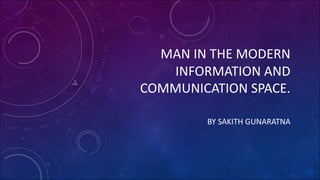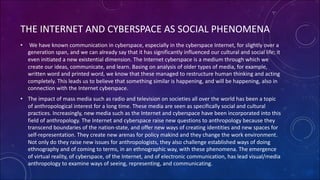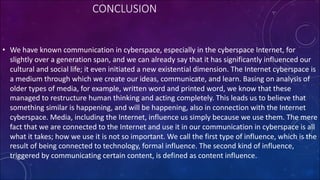The document discusses the concepts of cyberspace and the impact of modern communication technologies on human existence. It defines cyberspace as the communication space enabled by technologies like the internet, which allows people to communicate, work and learn across physical distances. While expanding opportunities for connection, cyberspace also influences human thinking patterns and relationships with time, space and identity. Both positives like access to information and negatives like distraction are discussed. The conclusion is that merely using technologies like the internet formally influences human life through restructuring thinking and behavior.








![Structure of thinking
. In communication within cyberspace, some structural changes in thinking and
consequently in learning occur. Each media has its own semiotics, and the most
fundamental media, for example, spoken word, found their new cultural epochs.
Therefore, media are tools for our thinking and learning. Bystřický [18], for instance,
says that “we also use different ways of thinking with increased use of technologies, not
in terms of changing the actual availability of such abilities; we rather fundamentally
alter strategy of their use.” Thinking in cyberspace is influenced by discontinuity of
images, short texts, and similar, which does not help us to train concentration and
continual refinement of ideas. On the contrary, a text in a newspaper or book requires
us to concentrate and pursue the logical chain of ideas that are expressed. Book and
newspaper thus develop abstract and logically continual thinking, while television and
especially the Internet nourish visual and discontinuous thinking.](https://image.slidesharecdn.com/presentation1-230309112936-7780d983/85/Presentation-1-pdf-9-320.jpg)

